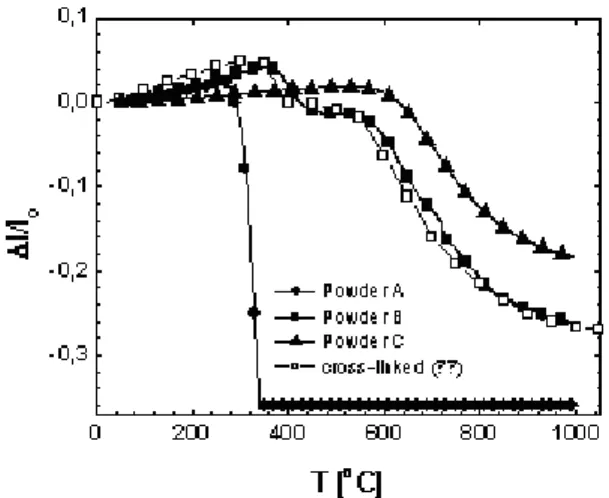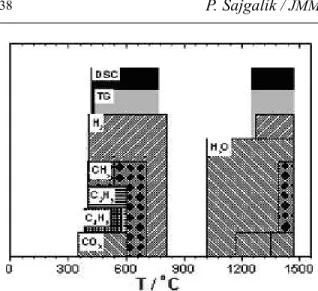THERMAL ANALYSIS STUDY OF POLYMER-TO-CERAMIC
CONVERSION OF ORGANOSILICON PRECURSORS
D. Galusek*, Z. Lenčéš**, P. Šajgalík** and R. Riedel***
*Vitrum Laugaricio – Joint Glass Centre of IIC SAS, TnU AD, and RONA, j.s.c., Študentská 2, 911 50 Trenčín, Slovak Republic,
**Institute of Inorganic Chemistry, Slovak Academy of Sciences, Dúbravská cesta 9, 845 36 Bratislava, Slovak Republic,
***Institute of Materials Science, Darmstadt University of Technology, Petersenstrasse 23, D 64287 Darmstadt, Germany
Dedicated to Prof. Ing. Jaroslav Šesták, DrSc. at the occasion of his 70th birthday
(Received 07 June 2008; accepted 10 October 2008)
Abstract
The organosilicon precursors attract significant attention as substances, which upon heating in inert or reactive atmosphere convert directly to oxide or non-oxide ceramics, like nitrides, carbides, carbonitrides, boroncarbonitrides, oxycarbides, alons, etc. In characterisation, and in study of conversion of these polymers to ceramics thermal analysis plays an important role. The degree of cross-linking of the polymer vital for achievement of high ceramic yield is estimated with the use of thermal mechanical analysis (TMA). Decomposition of polymers and their conversion to ceramics is studied by the combination of differential thermal analysis (DTA), differential scanning calorimetry (DSC) thermogravimetry(TG), and mass spectrometry (MS). The use of these methods in study of the polymer-to-ceramic conversion is illustrated by case studies of a commercially available poly(allyl)carbosilane as the precursor of SiC, and a poly(hydridomethyl)silazane as the precursor of SiCN.
Keywords: Organosilicon precursors, DSC, TG, DTA
* Corresponding author: sajgalik@savba.sk
DOI:10.2298/JMMB0801035G
J o u r n a l o f
M i n i n g a n d
M e t a l l u r g y
1. Introduction
Recent progress in the field of synthesis of pre-ceramic organometallic polymers opens new possibilities for the use of ceramic materials in a wide range of applications. [1,2,3] The pre-ceramic polymers can be formed by well established techniques used for traditional polymers, like casting, injection molding, spinning, coating, or used for modification of the microstructure of ceramics by infiltration or coating of ceramic powders. However, the key to successful preparation of defect-free ceramic materials is the information on the degree of cross-linking of the polymer used in the process, and detailed knowledge of the chemical processes, which take place in the course of the polymer’s conversion to ceramics. Thermoanalytical methods are therefore widely used in characterisation of these polymers, and in study of ceramisation of these substances. The use of thermoanalytical methods is illustrated in this paper by case studies of polymer-to-ceramic conversion of a SiC precursor poly(allyl)carbosilane, and a SiCN precursor poly(hydridomethyl)silazane.
2. Experimental
The degree of cross-linking of studied polymers was estimated by thermal mechanical analysis (TMA, Netzsch TMA 402, flowing Ar, temperature interval 25
-1000°C, heating rate 300ºC/h-1), and by termogravimetry measurements (Netzsch STA 429, identical conditions). Thermal decomposition of the polymers was examined by simultaneous thermal analysis (STA, Netzsch STA 429), coupled with mass
spectrometry (Balzers MID) in the temperature range 20 - 1500ºC.
3. Results and Discussion
The degree of cross-linking of the polymer is vital for obtaining high ceramic yield and sufficient mechanical strength of the product. Optimum degree of cross-linking prevents the melting of the precursor in the course of its ceramisation, and decreases the fraction of low molecular weight oligomers, which cause bubble or crack formation and bloating of the resulting ceramic body. TMA behaviour of variously cross-linked poly(hydrido-methyl)silazane is shown in Fig. 1. Powder A melts at T ≥ 280°C indicating the polymer is under-cross-linked. Shrinkage of powder B between 340 and 600°C is due to partial softening of the polysilazane. As reported by Riedel[4] and Frieß[5], such behaviour is suitable for processing of monolithic SiCN ceramics: partial softening of polymer allows formation of good contacts and chemical bonds among the powder particles, resulting in ceramic body with good mechanical
P. Šajgalík/ JMM 44 B (2008) 35 - 38
36
strength. This characteristic behaviour is not observed in powder C, which is considered as over-cross-linked. The much lower linear shrinkage of powder C (19 %) at T ≥600ºC in comparison with powder B is attributed to smaller extent of structural rearrangements in the course of polymer ceramisation in powder C, where a rigid 3-D network has been created in the course of cross-linking. Majority of volatile species have been also removed from the powder C during cross-linking, which is reflected in lower mass loss upon heating to 800ºC in comparison with powder B (Fig. 2). However, higher degree of cross-linking also decreases the number of reaction sites at the surface of polymer particles, thus reducing the number of bonds between them: ceramic bodies with poor mechanical properties therefore result from overcross-linked powder. On the other hand, undercrosslinked bodies bloat due to the evolution of high molecular weight oligomers in molten polymer matrix.
The thermal analysis of poly(allyl)-carbosilane revealed the plain polymer behaved differently when compared with the polymer/alumina mixture (Fig. 3). The
mixture was prepared in order to verify the possibility of using the polymer as the source of SiC in Al2O3-SiC nanocomposites. Two weight decreases between 400 and 480°C, and 480 and 750°C accompanied by exothermic effect were observed both in plain and alumina-mixed polymer, and were attributed to cross-linking of the polymer, and to the polymer-to-ceramics conversion. In plain polymer only small weight decrease was detected above 1100ºC, caused by the loss of residual hydrogen. The marked weight loss above 1200°C was observed in the polymer/ alumina mixture.
The results of mass spectrometry of the polymer/alumina mixture agree well with the TG/DSC data, and the intervals of the development of gaseous products overlap with the temperature ranges of weight losses. The results are shown in Figure 4. The mass spectrometry measurements show that the decomposition of the polymer in Ar was accompanied by development of H2, hydrocarbons, and small amounts of H2O from the surface of alumina particles.
P. Šajgalík/ JMM 44 B (2008) 35 - 38 37
Fig. 2 TG curves of optimum (B), and overcross-linked (C) powder.
Carbon monoxide evolved as the result of pyrolytic cracking of hydrocarbons, and the reaction of precipitated carbon with water vapour. The infrared spectroscopy coupled with mass spectrometry confirmed the presence of CO, originating from carbothermal reduction of silica at temperatures above 1200ºC. This knowledge was vital for the optimisation of sintering regime of polymer-derived Al2O3-SiC nanocomposites.
4. Conclusions
The conditions of cross-linking and pyrolysis, and heating regimes that facilitate successful preparation of various polymer-derived ceramics can be optimised with the aid of the TMA/STA/MS analysis.
Acknowledgement
The financial support of this work by the Alexander von Humboldt Foundation, Bonn, Germany, and by VEGA, grant No 2/6181/26 and APVV RPEU – 0013 – 06 , is gratefully acknowledged.
References
1. R.P.J. Corriu, Angew.Chem.Int.Ed., 39 (2000) 1376-98
2. P. Greil, J.Am.Ceram.Soc., 78 (1995) 835-48
3. R. Riedel, W. Dressler, Ceram.Int., 22 (1996) 233-39
4. R. Riedel, G. Passing, H. Schönfelder, R. J. Brook, Nature, 355 (1992) 714-716
5. M. Frieß, Ph.D. Thesis, University of Stuttgart, 1994
P. Šajgalík/ JMM 44 B (2008) 35 - 38
38


